Differences between IFRS and GAAP: An Accounting Report
VerifiedAdded on 2021/05/31
|8
|2155
|239
Report
AI Summary
This report provides a detailed comparison of International Financial Reporting Standards (IFRS) and Generally Accepted Accounting Principles (GAAP), focusing on key differences in accounting for inventories, fixed assets, intangible assets, and development costs. It highlights the terminological differences and specific valuation methods, such as LIFO, and their impact on financial statements. The report further examines the adoption of IFRS in Singapore, explaining its alignment with international standards. It then explores why British, Chinese, and French listed companies might practice IFRS differently, considering factors like trade relations, financial markets, and economic integration. Finally, the report discusses the adjustments a German company would need to make when converting to IFRS, including currency gains, inventory valuation changes, depreciation, impairment, pension adjustments, repair expenses, and receivables, offering insights into the practical implications of adopting international accounting standards.
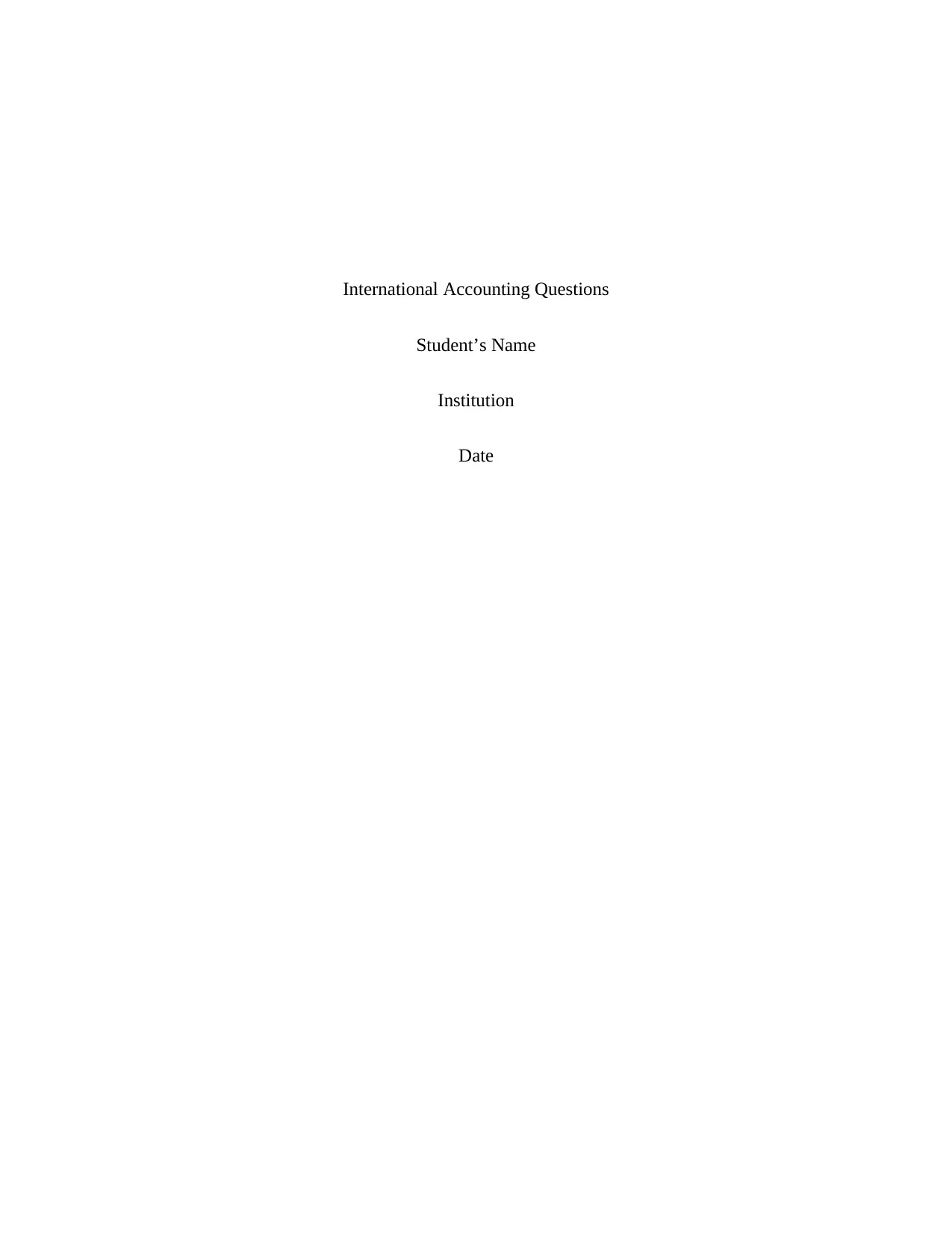
International Accounting Questions
Student’s Name
Institution
Date
Student’s Name
Institution
Date
Paraphrase This Document
Need a fresh take? Get an instant paraphrase of this document with our AI Paraphraser
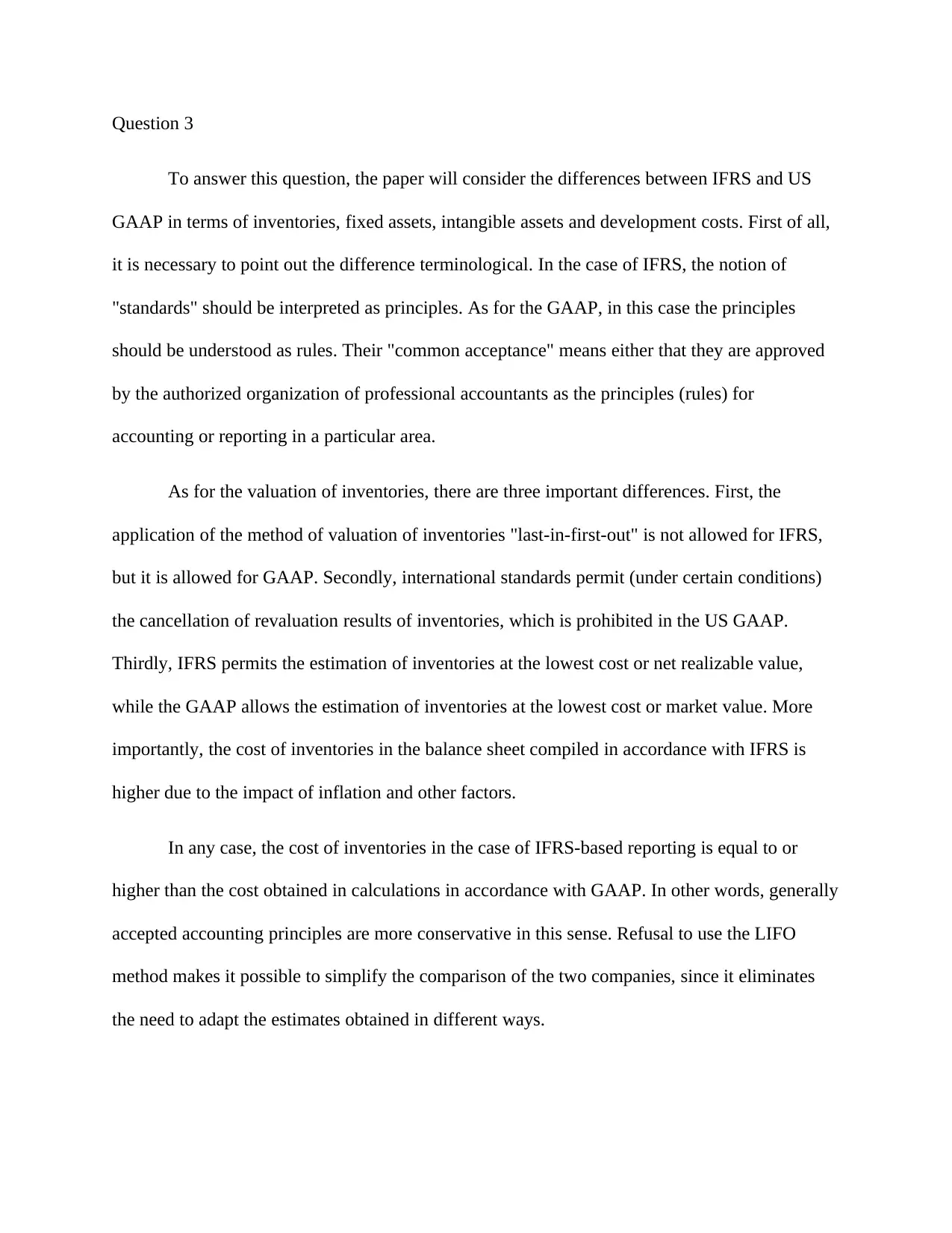
Question 3
To answer this question, the paper will consider the differences between IFRS and US
GAAP in terms of inventories, fixed assets, intangible assets and development costs. First of all,
it is necessary to point out the difference terminological. In the case of IFRS, the notion of
"standards" should be interpreted as principles. As for the GAAP, in this case the principles
should be understood as rules. Their "common acceptance" means either that they are approved
by the authorized organization of professional accountants as the principles (rules) for
accounting or reporting in a particular area.
As for the valuation of inventories, there are three important differences. First, the
application of the method of valuation of inventories "last-in-first-out" is not allowed for IFRS,
but it is allowed for GAAP. Secondly, international standards permit (under certain conditions)
the cancellation of revaluation results of inventories, which is prohibited in the US GAAP.
Thirdly, IFRS permits the estimation of inventories at the lowest cost or net realizable value,
while the GAAP allows the estimation of inventories at the lowest cost or market value. More
importantly, the cost of inventories in the balance sheet compiled in accordance with IFRS is
higher due to the impact of inflation and other factors.
In any case, the cost of inventories in the case of IFRS-based reporting is equal to or
higher than the cost obtained in calculations in accordance with GAAP. In other words, generally
accepted accounting principles are more conservative in this sense. Refusal to use the LIFO
method makes it possible to simplify the comparison of the two companies, since it eliminates
the need to adapt the estimates obtained in different ways.
To answer this question, the paper will consider the differences between IFRS and US
GAAP in terms of inventories, fixed assets, intangible assets and development costs. First of all,
it is necessary to point out the difference terminological. In the case of IFRS, the notion of
"standards" should be interpreted as principles. As for the GAAP, in this case the principles
should be understood as rules. Their "common acceptance" means either that they are approved
by the authorized organization of professional accountants as the principles (rules) for
accounting or reporting in a particular area.
As for the valuation of inventories, there are three important differences. First, the
application of the method of valuation of inventories "last-in-first-out" is not allowed for IFRS,
but it is allowed for GAAP. Secondly, international standards permit (under certain conditions)
the cancellation of revaluation results of inventories, which is prohibited in the US GAAP.
Thirdly, IFRS permits the estimation of inventories at the lowest cost or net realizable value,
while the GAAP allows the estimation of inventories at the lowest cost or market value. More
importantly, the cost of inventories in the balance sheet compiled in accordance with IFRS is
higher due to the impact of inflation and other factors.
In any case, the cost of inventories in the case of IFRS-based reporting is equal to or
higher than the cost obtained in calculations in accordance with GAAP. In other words, generally
accepted accounting principles are more conservative in this sense. Refusal to use the LIFO
method makes it possible to simplify the comparison of the two companies, since it eliminates
the need to adapt the estimates obtained in different ways.
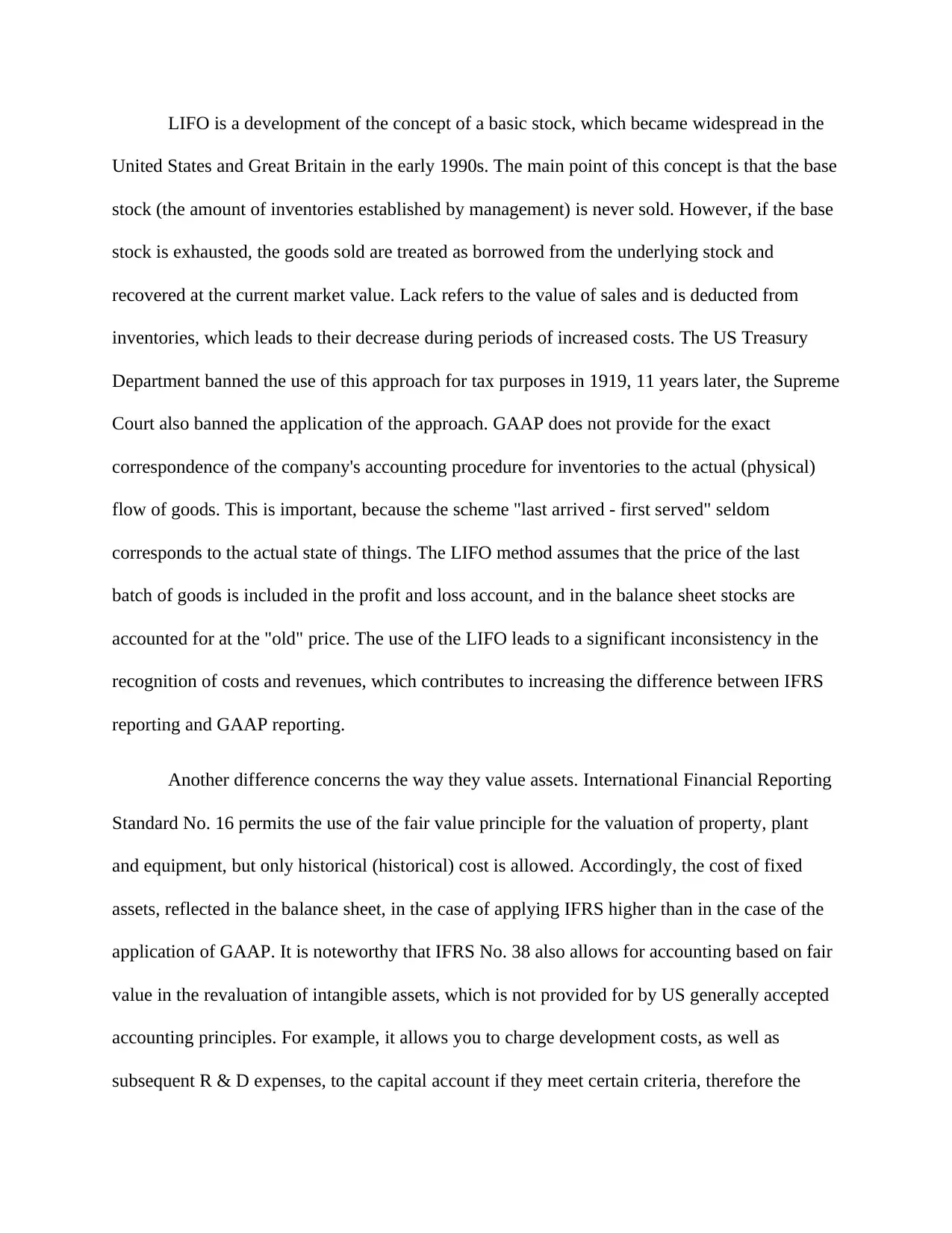
LIFO is a development of the concept of a basic stock, which became widespread in the
United States and Great Britain in the early 1990s. The main point of this concept is that the base
stock (the amount of inventories established by management) is never sold. However, if the base
stock is exhausted, the goods sold are treated as borrowed from the underlying stock and
recovered at the current market value. Lack refers to the value of sales and is deducted from
inventories, which leads to their decrease during periods of increased costs. The US Treasury
Department banned the use of this approach for tax purposes in 1919, 11 years later, the Supreme
Court also banned the application of the approach. GAAP does not provide for the exact
correspondence of the company's accounting procedure for inventories to the actual (physical)
flow of goods. This is important, because the scheme "last arrived - first served" seldom
corresponds to the actual state of things. The LIFO method assumes that the price of the last
batch of goods is included in the profit and loss account, and in the balance sheet stocks are
accounted for at the "old" price. The use of the LIFO leads to a significant inconsistency in the
recognition of costs and revenues, which contributes to increasing the difference between IFRS
reporting and GAAP reporting.
Another difference concerns the way they value assets. International Financial Reporting
Standard No. 16 permits the use of the fair value principle for the valuation of property, plant
and equipment, but only historical (historical) cost is allowed. Accordingly, the cost of fixed
assets, reflected in the balance sheet, in the case of applying IFRS higher than in the case of the
application of GAAP. It is noteworthy that IFRS No. 38 also allows for accounting based on fair
value in the revaluation of intangible assets, which is not provided for by US generally accepted
accounting principles. For example, it allows you to charge development costs, as well as
subsequent R & D expenses, to the capital account if they meet certain criteria, therefore the
United States and Great Britain in the early 1990s. The main point of this concept is that the base
stock (the amount of inventories established by management) is never sold. However, if the base
stock is exhausted, the goods sold are treated as borrowed from the underlying stock and
recovered at the current market value. Lack refers to the value of sales and is deducted from
inventories, which leads to their decrease during periods of increased costs. The US Treasury
Department banned the use of this approach for tax purposes in 1919, 11 years later, the Supreme
Court also banned the application of the approach. GAAP does not provide for the exact
correspondence of the company's accounting procedure for inventories to the actual (physical)
flow of goods. This is important, because the scheme "last arrived - first served" seldom
corresponds to the actual state of things. The LIFO method assumes that the price of the last
batch of goods is included in the profit and loss account, and in the balance sheet stocks are
accounted for at the "old" price. The use of the LIFO leads to a significant inconsistency in the
recognition of costs and revenues, which contributes to increasing the difference between IFRS
reporting and GAAP reporting.
Another difference concerns the way they value assets. International Financial Reporting
Standard No. 16 permits the use of the fair value principle for the valuation of property, plant
and equipment, but only historical (historical) cost is allowed. Accordingly, the cost of fixed
assets, reflected in the balance sheet, in the case of applying IFRS higher than in the case of the
application of GAAP. It is noteworthy that IFRS No. 38 also allows for accounting based on fair
value in the revaluation of intangible assets, which is not provided for by US generally accepted
accounting principles. For example, it allows you to charge development costs, as well as
subsequent R & D expenses, to the capital account if they meet certain criteria, therefore the
⊘ This is a preview!⊘
Do you want full access?
Subscribe today to unlock all pages.

Trusted by 1+ million students worldwide

intangible assets and the total value of the assets in the balance sheet are indicated in the balance
sheet more. International Financial Reporting Standard No. 38 relates development costs to
capital, and GAAP refers them to the costs of the period. The fact that in the balance sheet drawn
up in accordance with IFRS, high values of the total value of property are indicated, is due to
intangible assets and development costs.
Question 4
The reason why I would classify Singapore’s accounting system in 2018 is because
Singapore closely follows IFRS in its national accounting system. First, it is important to note
that Historically, the formats of financial statements varied widely in different countries, and the
accounting standards of each country were formed on the basis of a set of principles, rules or
arrangements, conditioned by the socio-political situation in that country. That is why Singapore
used to have accounting reporting that cannot be included in major accounting systems.
However, things have changed. In Singapore, accounting standards are known as the Singapore
Financial Reporting Standards (IFRS), they are based on IFRS. All companies whose reporting
period commenced on or after 1 January 2003 are required to comply with the requirements of
the SSFO. Accounting on an accrual basis is one of the basic principles of the Singapore
Accounting Standards. They use accrual basis to prepare financial statements. In accordance with
this method, transactions and other events are accounted for at the time when they occur (and not
at the time of receipt or payment of cash and cash equivalents), they are reflected in the
accounting records and in the financial statements for the periods to which they relate. Using
accrual basis, users are likely to know about past transactions with the payment and receipt of
cash, but also on obligations to pay cash in the future and on resources reflecting cash that will
sheet more. International Financial Reporting Standard No. 38 relates development costs to
capital, and GAAP refers them to the costs of the period. The fact that in the balance sheet drawn
up in accordance with IFRS, high values of the total value of property are indicated, is due to
intangible assets and development costs.
Question 4
The reason why I would classify Singapore’s accounting system in 2018 is because
Singapore closely follows IFRS in its national accounting system. First, it is important to note
that Historically, the formats of financial statements varied widely in different countries, and the
accounting standards of each country were formed on the basis of a set of principles, rules or
arrangements, conditioned by the socio-political situation in that country. That is why Singapore
used to have accounting reporting that cannot be included in major accounting systems.
However, things have changed. In Singapore, accounting standards are known as the Singapore
Financial Reporting Standards (IFRS), they are based on IFRS. All companies whose reporting
period commenced on or after 1 January 2003 are required to comply with the requirements of
the SSFO. Accounting on an accrual basis is one of the basic principles of the Singapore
Accounting Standards. They use accrual basis to prepare financial statements. In accordance with
this method, transactions and other events are accounted for at the time when they occur (and not
at the time of receipt or payment of cash and cash equivalents), they are reflected in the
accounting records and in the financial statements for the periods to which they relate. Using
accrual basis, users are likely to know about past transactions with the payment and receipt of
cash, but also on obligations to pay cash in the future and on resources reflecting cash that will
Paraphrase This Document
Need a fresh take? Get an instant paraphrase of this document with our AI Paraphraser
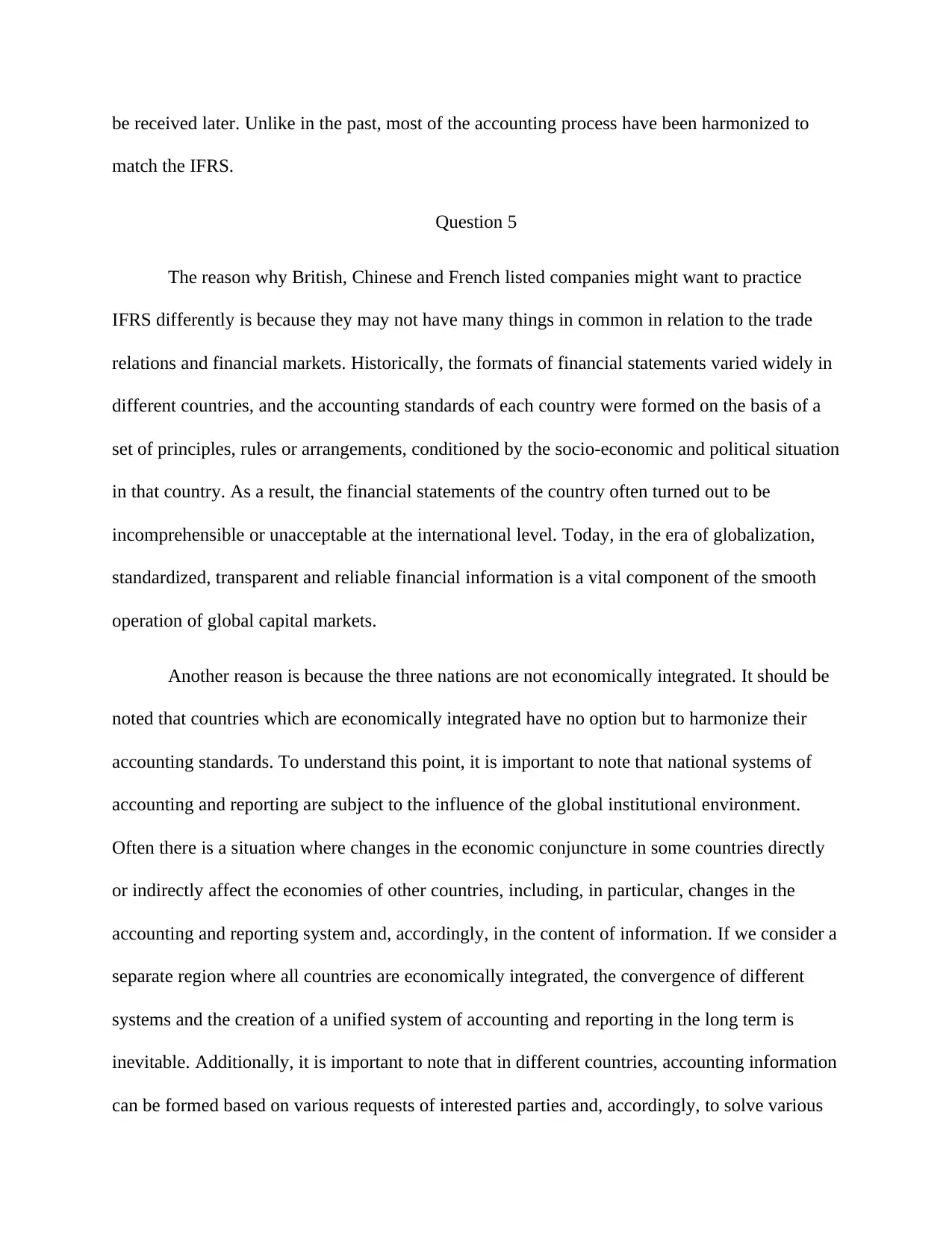
be received later. Unlike in the past, most of the accounting process have been harmonized to
match the IFRS.
Question 5
The reason why British, Chinese and French listed companies might want to practice
IFRS differently is because they may not have many things in common in relation to the trade
relations and financial markets. Historically, the formats of financial statements varied widely in
different countries, and the accounting standards of each country were formed on the basis of a
set of principles, rules or arrangements, conditioned by the socio-economic and political situation
in that country. As a result, the financial statements of the country often turned out to be
incomprehensible or unacceptable at the international level. Today, in the era of globalization,
standardized, transparent and reliable financial information is a vital component of the smooth
operation of global capital markets.
Another reason is because the three nations are not economically integrated. It should be
noted that countries which are economically integrated have no option but to harmonize their
accounting standards. To understand this point, it is important to note that national systems of
accounting and reporting are subject to the influence of the global institutional environment.
Often there is a situation where changes in the economic conjuncture in some countries directly
or indirectly affect the economies of other countries, including, in particular, changes in the
accounting and reporting system and, accordingly, in the content of information. If we consider a
separate region where all countries are economically integrated, the convergence of different
systems and the creation of a unified system of accounting and reporting in the long term is
inevitable. Additionally, it is important to note that in different countries, accounting information
can be formed based on various requests of interested parties and, accordingly, to solve various
match the IFRS.
Question 5
The reason why British, Chinese and French listed companies might want to practice
IFRS differently is because they may not have many things in common in relation to the trade
relations and financial markets. Historically, the formats of financial statements varied widely in
different countries, and the accounting standards of each country were formed on the basis of a
set of principles, rules or arrangements, conditioned by the socio-economic and political situation
in that country. As a result, the financial statements of the country often turned out to be
incomprehensible or unacceptable at the international level. Today, in the era of globalization,
standardized, transparent and reliable financial information is a vital component of the smooth
operation of global capital markets.
Another reason is because the three nations are not economically integrated. It should be
noted that countries which are economically integrated have no option but to harmonize their
accounting standards. To understand this point, it is important to note that national systems of
accounting and reporting are subject to the influence of the global institutional environment.
Often there is a situation where changes in the economic conjuncture in some countries directly
or indirectly affect the economies of other countries, including, in particular, changes in the
accounting and reporting system and, accordingly, in the content of information. If we consider a
separate region where all countries are economically integrated, the convergence of different
systems and the creation of a unified system of accounting and reporting in the long term is
inevitable. Additionally, it is important to note that in different countries, accounting information
can be formed based on various requests of interested parties and, accordingly, to solve various
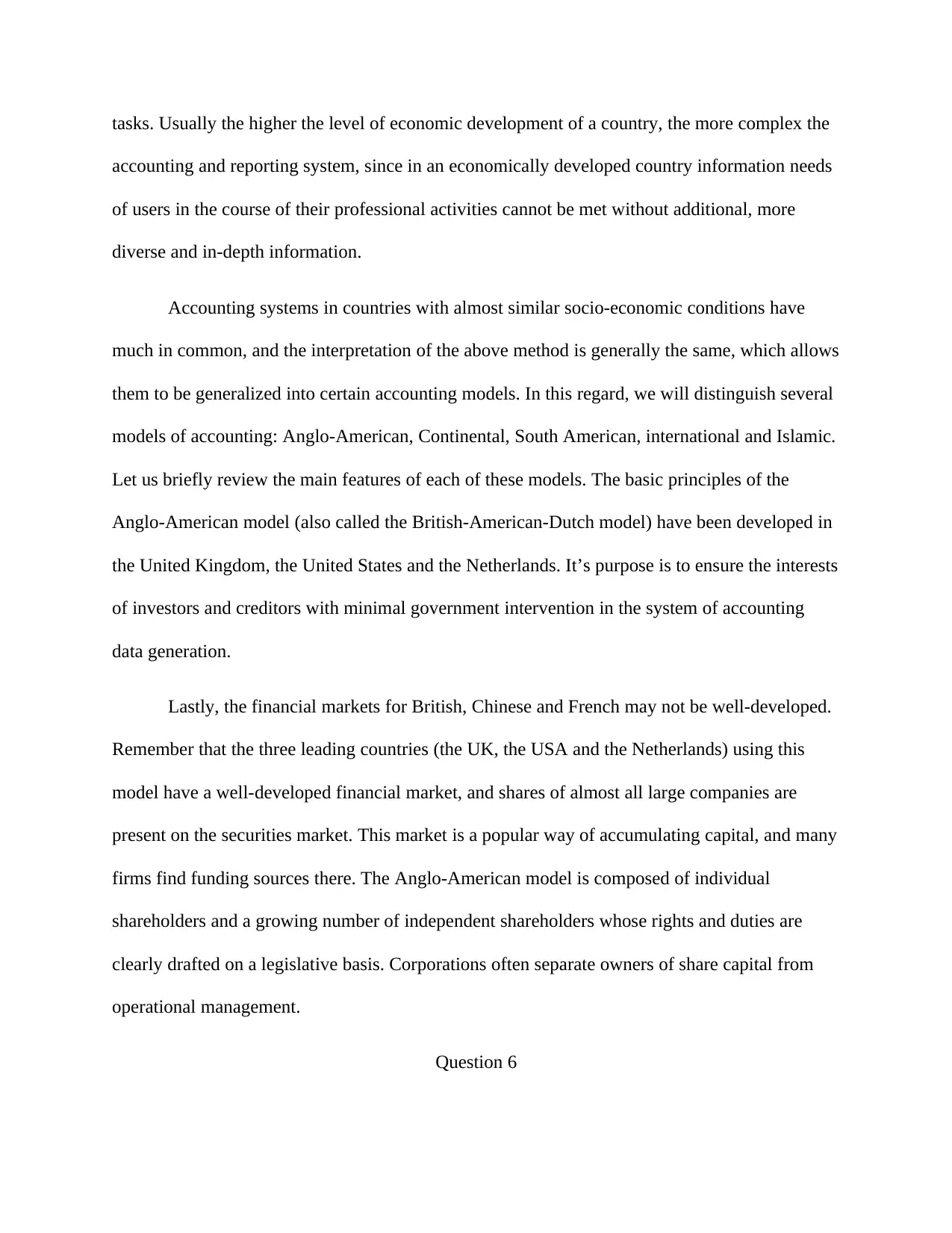
tasks. Usually the higher the level of economic development of a country, the more complex the
accounting and reporting system, since in an economically developed country information needs
of users in the course of their professional activities cannot be met without additional, more
diverse and in-depth information.
Accounting systems in countries with almost similar socio-economic conditions have
much in common, and the interpretation of the above method is generally the same, which allows
them to be generalized into certain accounting models. In this regard, we will distinguish several
models of accounting: Anglo-American, Continental, South American, international and Islamic.
Let us briefly review the main features of each of these models. The basic principles of the
Anglo-American model (also called the British-American-Dutch model) have been developed in
the United Kingdom, the United States and the Netherlands. It’s purpose is to ensure the interests
of investors and creditors with minimal government intervention in the system of accounting
data generation.
Lastly, the financial markets for British, Chinese and French may not be well-developed.
Remember that the three leading countries (the UK, the USA and the Netherlands) using this
model have a well-developed financial market, and shares of almost all large companies are
present on the securities market. This market is a popular way of accumulating capital, and many
firms find funding sources there. The Anglo-American model is composed of individual
shareholders and a growing number of independent shareholders whose rights and duties are
clearly drafted on a legislative basis. Corporations often separate owners of share capital from
operational management.
Question 6
accounting and reporting system, since in an economically developed country information needs
of users in the course of their professional activities cannot be met without additional, more
diverse and in-depth information.
Accounting systems in countries with almost similar socio-economic conditions have
much in common, and the interpretation of the above method is generally the same, which allows
them to be generalized into certain accounting models. In this regard, we will distinguish several
models of accounting: Anglo-American, Continental, South American, international and Islamic.
Let us briefly review the main features of each of these models. The basic principles of the
Anglo-American model (also called the British-American-Dutch model) have been developed in
the United Kingdom, the United States and the Netherlands. It’s purpose is to ensure the interests
of investors and creditors with minimal government intervention in the system of accounting
data generation.
Lastly, the financial markets for British, Chinese and French may not be well-developed.
Remember that the three leading countries (the UK, the USA and the Netherlands) using this
model have a well-developed financial market, and shares of almost all large companies are
present on the securities market. This market is a popular way of accumulating capital, and many
firms find funding sources there. The Anglo-American model is composed of individual
shareholders and a growing number of independent shareholders whose rights and duties are
clearly drafted on a legislative basis. Corporations often separate owners of share capital from
operational management.
Question 6
⊘ This is a preview!⊘
Do you want full access?
Subscribe today to unlock all pages.

Trusted by 1+ million students worldwide
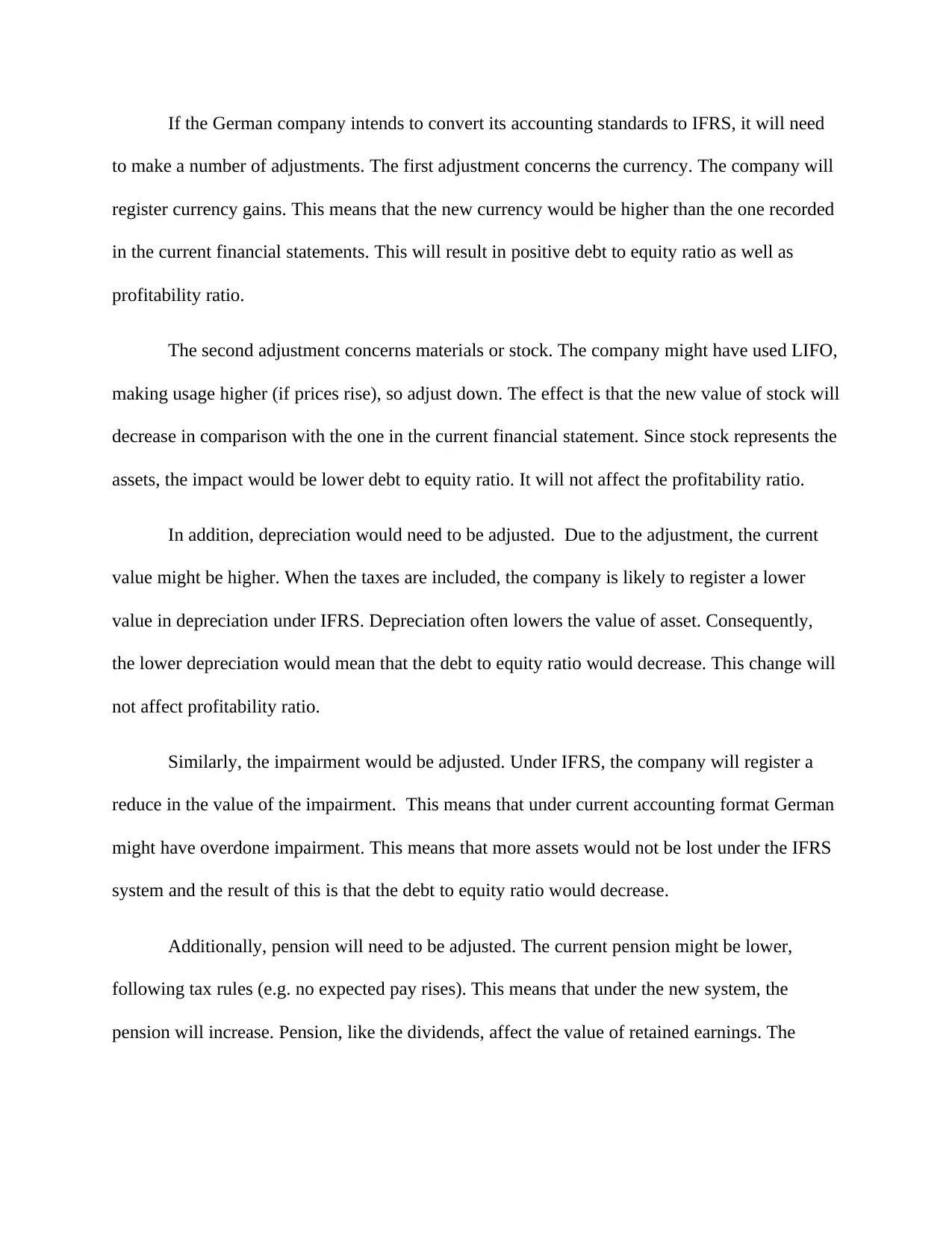
If the German company intends to convert its accounting standards to IFRS, it will need
to make a number of adjustments. The first adjustment concerns the currency. The company will
register currency gains. This means that the new currency would be higher than the one recorded
in the current financial statements. This will result in positive debt to equity ratio as well as
profitability ratio.
The second adjustment concerns materials or stock. The company might have used LIFO,
making usage higher (if prices rise), so adjust down. The effect is that the new value of stock will
decrease in comparison with the one in the current financial statement. Since stock represents the
assets, the impact would be lower debt to equity ratio. It will not affect the profitability ratio.
In addition, depreciation would need to be adjusted. Due to the adjustment, the current
value might be higher. When the taxes are included, the company is likely to register a lower
value in depreciation under IFRS. Depreciation often lowers the value of asset. Consequently,
the lower depreciation would mean that the debt to equity ratio would decrease. This change will
not affect profitability ratio.
Similarly, the impairment would be adjusted. Under IFRS, the company will register a
reduce in the value of the impairment. This means that under current accounting format German
might have overdone impairment. This means that more assets would not be lost under the IFRS
system and the result of this is that the debt to equity ratio would decrease.
Additionally, pension will need to be adjusted. The current pension might be lower,
following tax rules (e.g. no expected pay rises). This means that under the new system, the
pension will increase. Pension, like the dividends, affect the value of retained earnings. The
to make a number of adjustments. The first adjustment concerns the currency. The company will
register currency gains. This means that the new currency would be higher than the one recorded
in the current financial statements. This will result in positive debt to equity ratio as well as
profitability ratio.
The second adjustment concerns materials or stock. The company might have used LIFO,
making usage higher (if prices rise), so adjust down. The effect is that the new value of stock will
decrease in comparison with the one in the current financial statement. Since stock represents the
assets, the impact would be lower debt to equity ratio. It will not affect the profitability ratio.
In addition, depreciation would need to be adjusted. Due to the adjustment, the current
value might be higher. When the taxes are included, the company is likely to register a lower
value in depreciation under IFRS. Depreciation often lowers the value of asset. Consequently,
the lower depreciation would mean that the debt to equity ratio would decrease. This change will
not affect profitability ratio.
Similarly, the impairment would be adjusted. Under IFRS, the company will register a
reduce in the value of the impairment. This means that under current accounting format German
might have overdone impairment. This means that more assets would not be lost under the IFRS
system and the result of this is that the debt to equity ratio would decrease.
Additionally, pension will need to be adjusted. The current pension might be lower,
following tax rules (e.g. no expected pay rises). This means that under the new system, the
pension will increase. Pension, like the dividends, affect the value of retained earnings. The
Paraphrase This Document
Need a fresh take? Get an instant paraphrase of this document with our AI Paraphraser
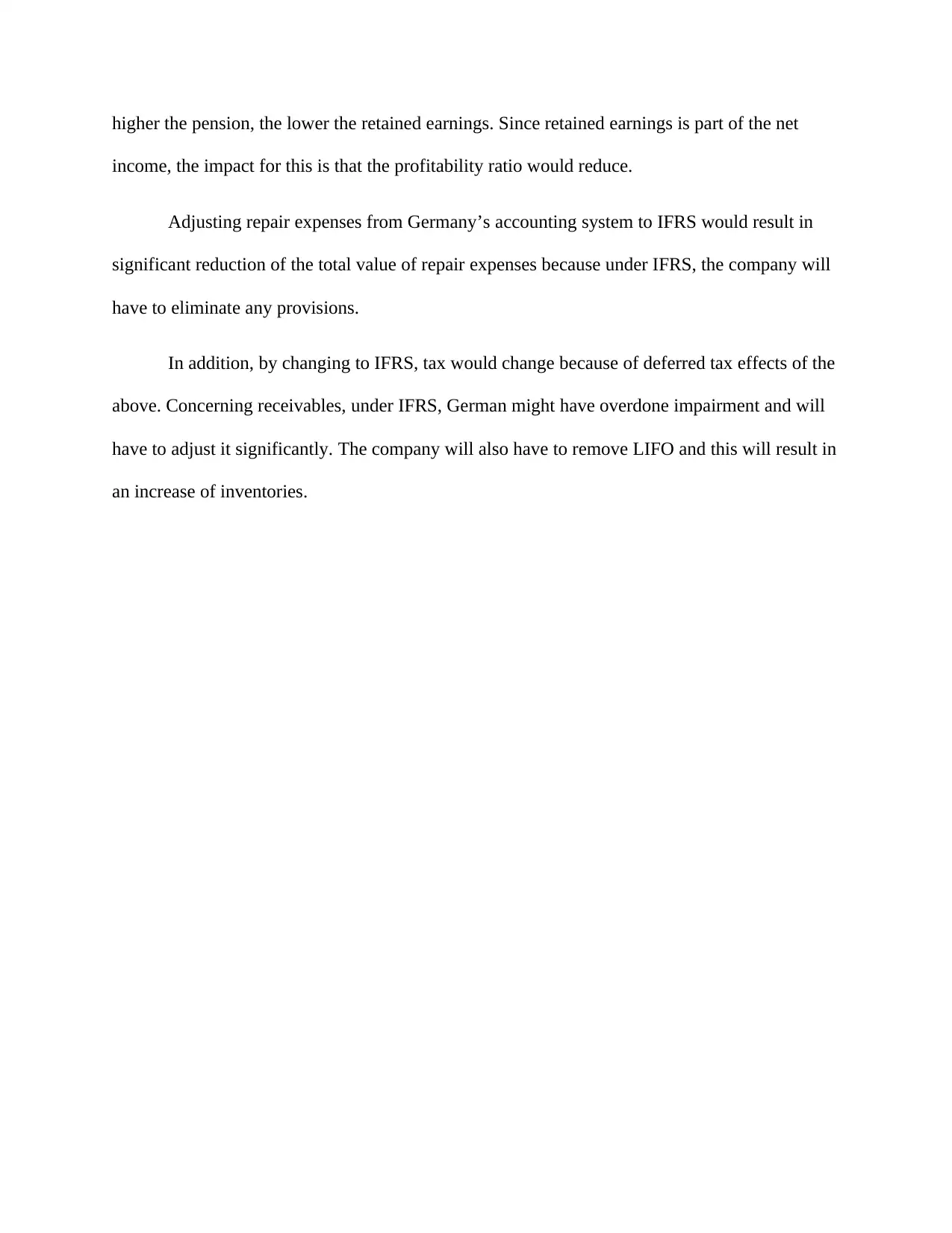
higher the pension, the lower the retained earnings. Since retained earnings is part of the net
income, the impact for this is that the profitability ratio would reduce.
Adjusting repair expenses from Germany’s accounting system to IFRS would result in
significant reduction of the total value of repair expenses because under IFRS, the company will
have to eliminate any provisions.
In addition, by changing to IFRS, tax would change because of deferred tax effects of the
above. Concerning receivables, under IFRS, German might have overdone impairment and will
have to adjust it significantly. The company will also have to remove LIFO and this will result in
an increase of inventories.
income, the impact for this is that the profitability ratio would reduce.
Adjusting repair expenses from Germany’s accounting system to IFRS would result in
significant reduction of the total value of repair expenses because under IFRS, the company will
have to eliminate any provisions.
In addition, by changing to IFRS, tax would change because of deferred tax effects of the
above. Concerning receivables, under IFRS, German might have overdone impairment and will
have to adjust it significantly. The company will also have to remove LIFO and this will result in
an increase of inventories.
1 out of 8
Related Documents
Your All-in-One AI-Powered Toolkit for Academic Success.
+13062052269
info@desklib.com
Available 24*7 on WhatsApp / Email
![[object Object]](/_next/static/media/star-bottom.7253800d.svg)
Unlock your academic potential
Copyright © 2020–2025 A2Z Services. All Rights Reserved. Developed and managed by ZUCOL.




